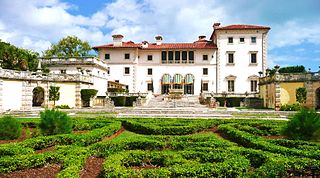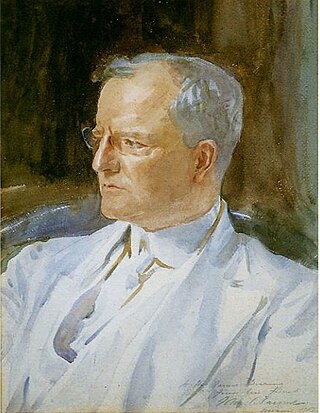
The Vizcaya Museum and Gardens, previously known as Villa Vizcaya, is the former villa and estate of businessman James Deering, of the Deering McCormick-International Harvester fortune, on Biscayne Bay in the present-day Coconut Grove neighborhood of Miami, Florida. The early 20th-century Vizcaya estate also includes extensive Italian Renaissance gardens, native woodland landscape, and a historic village outbuildings compound.

USS Impetuous (PYc-46) was a private yacht purchased by the Navy in August 1940 that served as a patrol boat of the United States Navy in Central America. The yacht was built as Paragon, the first of at least two Davol yachts to bear the name, in 1915 for Charles J. Davol of Providence, Rhode Island. In 1916 Davol sold the yacht to John Fred Betz, 3d of Philadelphia who renamed the yacht Sybilla III which served as the Section Patrol yacht USS Sybilla III (SP-104) from May 1917 to December 1918. Sybilla III remained in Betz's ownership until sale in 1935 to R. Livingston Sullivan of Philadelphia who renamed the yacht Arlis. On 12 August 1940 the Navy purchased the yacht placing it in commission as USS PC-454 on 16 October. The vessel was given the name Impetuous and reclassified PYc-46 on 15 July 1943. The yacht was decommissioned at Philadelphia 31 August 1944 and transferred to the War Shipping Administration for sale.

Charles Deering was an American businessman, art collector, and philanthropist. He was an executive of the agricultural machinery company founded by his father that became International Harvester. Charles's successful stewardship of the family firm left him with the means and leisure to indulge his interests in the arts and natural sciences. His activities and benefactions in the US were centered on Chicago and Miami; he also aspired to found an art museum in Spain.
Francis Burrall Hoffman was an American-born architect, best known for his work with James Deering’s Villa Vizcaya in Miami, Florida.

James Deering was an American executive in the management of his family's Deering Harvester Company and later International Harvester, as well as a socialite and an antiquities collector. He built his landmark Vizcaya estate, where he was an early 20th-century resident on Biscayne Bay in the present day Coconut Grove district of Miami, Florida. Begun in 1910, with architecture and gardens in a Mediterranean Revival style, Vizcaya was his passionate endeavor with artist Paul Chalfin, and his winter home from 1916 to his death in 1925.

Charles Deering Estate was the Florida home of Charles Deering until 1927 when he died at the estate.

USS Edithena was a United States Navy patrol vessel in commission from 1917 to 1919 that saw service during World War I. Prior to her U.S. Navy service, she operated as the private motor yacht Edithena from 1914 to 1917. After the conclusion World War I, she served as the fishery patrol vessel USFS Widgeon in the fleet of the United States Bureau of Fisheries from 1919 to 1940 and as US FWS Widgeon in the fleet of the Fish and Wildlife Service from 1940 to 1942. During World War II, she returned to U.S. Navy service from 1942 to 1944 as the yard patrol boat USS YP-200. By 1947 she had returned to private ownership, first as Edithena and during the 1970s and 1980s as the fishing vessel Ila Mae.

USCGC Tallapoosa (WPG-52) was a United States Coast Guard cutter of the Tallapoosa-class and was designed to replace the revenue cutter Winona. Her hull was reinforced for light icebreaking. She was initially stationed at Mobile, Alabama, with cruising grounds to Lake Pontchartrain, Louisiana and Fowey Rocks, Florida. During World War I she escorted convoys out of Halifax, Nova Scotia. After the war she served with the Bering Sea Patrol before returning to Savannah, Georgia before World War II. During the war Tallapoosa assisted with convoy escort duty and anti-submarine patrols.

Idealia was America's first diesel powered yacht built and owned by the Electric Launch Company (ELCO). The yacht was built in 1911, launched in 1912 and demonstrated the potential for use of diesel engines in yachts for several years thereafter. She yacht performed a public trial on the Hudson River on 22 October 1913 under the supervision of ELCO's manager Henry R. Sutphen with a gathering of naval architects and engineers as observers. Idealia was sold to individual owners after its period of demonstrating the diesel engine's pleasure craft utility.

USS Druid (SP-321) was a private yacht launched 10 February 1902 as Rheclair that was built for Daniel G. Reid. Reid sold the yacht to Senator Nelson W. Aldrich who renamed the yacht Nirvana only just over a year before his death. Aldrich's estate chartered Nirvana to John Wanamaker until it was bought by his son Rodman Wanamaker who used the yacht for cruising until a fire on 14 December 1916, just before a cruise south, severely damaged the vessel. He chartered an alternate vessel for his trip south and, after full repairs, the yacht was sold to Walter W. Dwyer who gave it the name Druid with intentions to sell the yacht to the government in order to finance a shipyard venture in Pensacola, Florida.

The second USS Tacony (SP-5) was an armed yacht that served in the United States Navy as a Section patrol vessel from 24 May 1917 to 29 November 1918. The yacht had been built in 1911 by the Mathis Yacht Building Company at Camden, New Jersey for John Fred Betz, III, of Essington, Pennsylvania and member of the Philadelphia Yacht Club as Sybilla II. The vessel was Mathis yard number seven with 208469 the official number issued.

USS Calabash (SP-108) was a civilian motor yacht that served in the 7th Naval District as an armed patrol boat in the United States Navy during July and August 1917. Apparently found unsuitable for naval service, Calabash served for less than a month before being decommissioned and returned to her owner in August 1917.

USS Coco (SP-110) was an armed motorboat that served in the United States Navy as a Section patrol vessel from 1917 to 1919.

USC&GS Isis was a survey ship that served in the United States Coast and Geodetic Survey from 1915 to 1917 and from 1919 to 1920.

USS Ameera (SP-453) was a United States Navy Section patrol vessel in commission from 1917 to 1919.

USS Marold (SP-737) was a United States Navy patrol vessel in commission from 1917 to 1919.
USS Marpessa (SP-787) was a 50 foot "express yacht" that became a United States Navy section patrol vessel in commission from 1917 to 1919 retaining the civilian name.

Anton Dohrn was a motor yacht built during 1911 and delivered to the Carnegie Institution of Washington in June 1911 for use at its Department of Marine Biology laboratory at Dry Tortugas, Florida. The institution leased the vessel to the United States Navy for use as a patrol boat during World War I to serve as USS Anton Dohrn 5 October 1917 – 2 January 1919. The vessel remained in service for the institution until 1940 when Anton Dohrn was given to the Woods Hole Oceanographic Institution which used the vessel until 1947 for work between the Gulf of Maine and New Jersey. In 1947 the vessel was sold for use as a mail boat between New Bedford and Cuttyhunk Island.

USS Louise No. 2 (SP-1230), sometimes written Louise # 2 and also referred to during her naval career as Louise and as Pilot Boat No. 2, was a United States Navy patrol vessel in commission from 1917 to 1919. The Louise, was a pilot boat from 1900 to 1917. She was a replacement for the pilot boat Columbia, that was washed ashore in 1898. After the World War I the Louise returned to pilot service until 1924 when she was purchased as a yacht. In 1924, the Boston pilot boat Pilot, took the place of the Louise.

Rosinco was a diesel-powered luxury yacht that sank in Lake Michigan off the coast of Kenosha, Wisconsin in 1928. The yacht was built in 1916 as Georgiana III and served during World War I as USS Georgiana III, a Section patrol craft, under a free lease to the Navy by her owner and commanding officer. After the war the yacht was sold and renamed Whitemarsh in 1918. In 1925, after sale to Robert Hosmer Morse of Fairbanks-Morse, the yacht became Rosinco. She was sunk following a collision in 1928 and the wreck was added to the National Register of Historic Places in 2001.

















